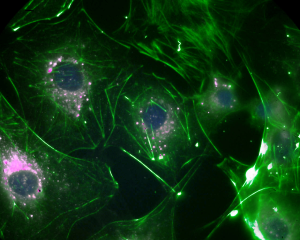Intracellular lipid-rich organelles known as lipid droplets have been shown to be important both physiologically and pathologically. The LipiBright™ probes consists of bright, fluorogenic live cell dyes that stain lipid droplets. LipiBright™ probes fluoresce 300 to 1000 times brighter in an oily/lipid environment compared to aqueous solutions1. The probes are available in three different colors; yellow: LipiBright™ 530 SMCy3.5 (Em = 570-610 nm), far red: LipiBright™ 650 SMCy5.5 (Em = 680-720 nm) and near-infrared: LipiBright™ 700 SMCy7 (Em = 770-810 nm). LipiBright probes are photostable and possess narrow absorption and emission bands, a distinct advantage over the traditional Nile Red probe; thus, multicolor imaging is possible. These probes exhibit ideal characteristics for microscopy and have been validated with multiple techniques including epifluorescent (widefield), confocal, and two photon1. With high GM values (2400 to 13300), the LipiBright SMCy3.5 and SMCy5.5 probes have been confirmed to work with two photon microscopy to work in multiple models including cells and tissues1.
LipiBright™ 700 SMCy7.0: Fluorogenic Lipid Droplet Probe Product Functions (MG13)
-
Labeling the lipid droplets of live cells in culture
For more detailed information on using this product see the About Tab
LipiBright™ is a trademark of CNRS/UNISTRA of France.

Figure. Swiss3T3 cell monolayer labeled with LipiBright™ SMCy7.0. Widefield fluorescent imaging of live Swiss3T3 labeled with 340 nM LipiBright™ SMCy7.0 (white). Cells were imaged as described in Application 1 methods. LipiBright™ Cells were visualized with an infrared filter set, a digital CCD camera, and 40x objective.
Material
LipiBright™ SMCy7.0 can be visualized using a Cy7 or infrared filter set. As measured in DMSO, the absorption max of LipiBright™ SMCy7.0 in oil is 700 nm, with an emission maximum of 770 nm, an extinction coefficient of 231x103, and LipiBright™ SMCy7.0 is supplied as a lyophilized pellet. Avoid contact with LipiBright™ by wearing appropriate PPE and dispose of according to local regulations and policies.
Storage and Reconstitution
The lyophilized product is stable at 4°C (<10% humidity) for 6 months and should be protected from light. To reconstitute, briefly centrifuge to collect the product at the bottom of the tube. LipiBright™ should be reconstituted with 200 µl of anhydrous DMSO to create a 340 µM stock solution for cell imaging or with 40 µl of anhydrous DMSO to create a 1.5 mM stock suitable for tissue or small organism imaging. After reconstitution the solution should be stored at -20°C where it is stable for 6 months. Once reconstituted, allow product to warm to room temperature before opening tube.
Important Technical Notes
B. Serum can reduce LipiBright™ staining efficiency. When possible LipiBright™ staining should take place in the absence of serum. Optimally, the imaging cell media is serum-free media, reduced serum media, or PBS. In lieu of serum remov-al, the concentration of LipiBright™ should be increased.
D. LipiBright™ is non-toxic and live cells can be returned to normal cell media following labeling, and they will remain-labeled for 2-4 days.
E. For tissues and small organisms an initial labeling concentra-tion of 3.4 µM is recommended. For cell culture an initial labeling concentration of 340 nM is recommended depending on application.
F. After uptake, LipiBright probes will be transported to lipid globules via the endosome pathway and Golgi apparatus, this process may take a few hours, 4-6h, and hence the most defined staining is observed after this time.
G. For fixed cell applications: When co-labeling with antibodies that require permeabilization do not use Triton-X, but replace it with saponin or digitonin which are milder (see Ohsake et al. 2005).
H. LipiBright™ is fully compatible with 4% paraformaldehyde (PFA) or 1% glutaraldehyde. Staining should be performed before fixation i.e. in live cells, in order to allow its localization to lipid droplets which takes a 4-6h.
Reagents
1. LipiBright™ SMCy7.0 (Cat. # MG13).
2. Semi-confluent Swiss 3T3 cells grown in a multi-well chamber or on25mm X 25mm sq glass coverslips.
3. Imaging medias: Serum-free DMEM media.
Equipment
2. Digital camera sensitive in the infrared.
Method
2. Aspirate media from cells and wash two times with serum free media. Do not allow the cells to dry.
3. Prepare the probe solution by diluting 4 µl of 340 µM LipiBright™ stock in to 4 ml serum free media to create a 340 nM working solution and mix thoroughly. Work quickly (<20 secs) as the probes will begin to aggregate reducing labeling efficiency.
4. Add diluted probe solution to cells and swirl gently until covered.
5. Incubate for 4-6h at 37°C, 5% CO2 and 95-100% humidity.
6. Wash coverslips gently twice with serum free media without probe. Do not pipette wash solution directly onto cells.
7. Replace with serum containing media without probe.
8. Proceed with imaging.
Product Citations
2. Ohsaki Y. et al. 2005. Fixation and permeabilization proto-col is critical for the immunolabeling of lipid droplet proteins. Histochem Cell Biol,124(5), p.445-52. doi: 10.1007/s00418-
005- 0061-5.
LipiBright™ is a trademark of CNRS/UNISTRA of France.
If you have any questions concerning this product, please contact our Technical Service department at tservice@cytoskeleton.com




